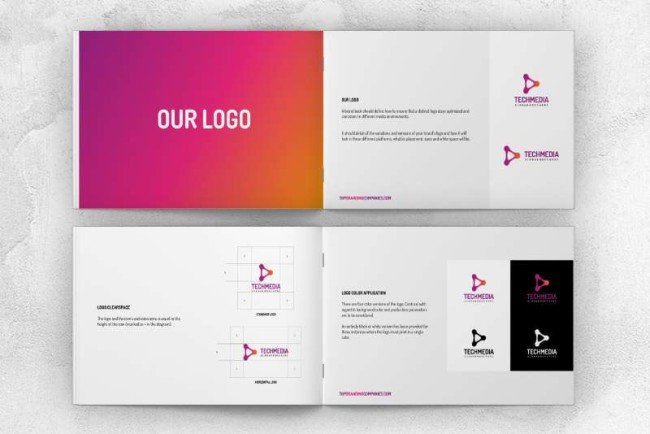What is a brand book?
A brand book is a document with a detailed description of the brand: from the philosophy of the company to the ways of arranging different versions of the logo. Any company needs such a document - it is a kind of manual that will help employees and contractors comply with the organization's policy and its visual style.

What is a brand book and why is it needed?
The size of the company's brand book may vary depending on the number of sections. A large international corporation may have a manual of many hundreds of pages, in which, for example, the nuances of communicating with clients and partners are spelled out in detail. Small companies, in which the policy is just being formed, may have a smaller brand book - it will be supplemented as the brand develops. Regardless of the size of the brand book, it is important that it accurately conveys the concept of the brand, its tone of voice, and the specifics of the corporate identity.
The following components of the brand book can be considered key:
- Detailed positioning description of brand platform. It includes the company's mission and values, a unique selling proposition, emotional and rational benefits.
- Consumer portrait - a description of the target audience of the brand.
- Brand promotion strategy.
- Brand name: its meaning, spelling, and pronunciation - if it is complex and non-obvious.
- Slogan or descriptor, if any.
- Brand name, its acceptable and unacceptable variants.
- Protective field of the logo - the minimum distance from the brand name to other elements on the layout, necessary to maintain readability.

- Brand fonts and how to combine them.
- Signature colors and ways to combine them.

- Additional branded graphics: patterns, textures, illustrations, iconography, peculiarities of working with photographic images, modular grids for the layout of printed and digital materials, rules for creating design layouts.
- Examples of media design. This section of the brand book shows how the design can look on real objects. For example, on product packaging, souvenirs, documents, employee uniforms, and other media that are relevant to a particular brand.
Sometimes, if necessary, additional information may be included in the brand book:
- The history of the formation of the company.
- Features of corporate etiquette, recommendations for communication within the team.
- Service standards and features of communication with clients at different sites: at points of sale, on the website, by phone, in social networks. The brand book may include scripts, scenarios, recommendations for responding to emergency situations.
- Recommendations for the design of the interior and exterior of the premises.
Why do you need a brand book?
A firm's brand book is a business tool that makes work more efficient. It will come in handy for the organization's staff members, freelancers, partners, advertising and design studios, which the company will contact in the future. The purpose of the brand book is to help maintain the brand image: from ideology to visuals.
Here is a list of the main features of the brand book:
- Maintaining a unified image of the company. The brand's mission and values, described in detail in the brand book, are reflected in all aspects of communication with the audience. Thoughtful leadership will help employees from different departments stay consistent in their work: marketers, copywriters, designers, salespeople and consultants will communicate the same brand values.
- Familiarization of new employees and contractors with the characteristics of the brand. Instead of explaining to each employee the requirements related to the specifics of the brand, you can simply give them a brand book to read.
- Help in the correct use of branded graphics. Not all corporate colours and fonts can be successfully combined with each other - there are acceptable and unacceptable combinations. It is also important to use the logo correctly, choose the right background and keep the right distance from other elements. Clear instructions will help content managers, marketers, SMM specialists and designers to maintain a corporate identity.
- Help in the quick preparation of any design layouts. The brand book includes design options for the main carriers of the corporate identity - advertising materials, packaging, souvenirs, documents. If a company needs to make packaging for a new product or release new souvenirs, you won't have to think long about their design - you can make a layout by analogy with the examples in the brand book. This optimizes uptime and costs.
Testimonials
How to use the brand book correctly?
Employees need to regularly consult the brand book to solve current problems. For example, thinking over texts for new advertising campaigns, training specialists in advising clients at points of sale and creating designs for banners, posts, or flyers.
Over time, souvenirs or promotional materials presented in the media section may become irrelevant for the company, and new ones will be required. In-house professionals, freelancers, or studios can develop new designs for promotions, promotions, events, or new product launches. At the same time, it is important to create new layouts taking into account the rules for using the corporate identity - to observe the protective field of the logo, modular grids, and acceptable combinations of colours and fonts.
Brand description and guidelines for the use of the logo and other visual elements are immutable rules. If they are violated, there is a risk that the brand will lose its recognition, cease to be attractive to the audience, and the design will look unprofessional.
Start Getting Results Online Today!